- About us»
- Net income calculator»
- Population aging»
-
- Least developed regions»
-
- Average wage
- Material need benefits
- Meal allowance
- Counties of Slovakia
- Inflation
- Living and Subsistence Minimum
- Unemployment of Czechia and Slovakia
- NACE Classification
-
- Life expectancy
- Gender differences
- Youth unemployment and NEET
- Minimum wage in EU
- Unemployment rates of different age groups
- Share of salaries on GDP
- Employment rate
- Percentage of employees ususally working at nights
- NEET
- Long term unemployment
- Unemployment rate
-
- Bratislava and surroundings
- Kopanice
- Danube river
- lower Vah river
- middle Vár river
- upper Nitra river
- lower Nitra river
- Mining cities
- Kysuce a Orava
- upper Vah river - Liptov
- Spiš cities
- upper Hron river
- Juhoslovenská kotlina
- Košice fold and Torysa river
- upper Zemplín
- lower Zemplín
- EU regions
- NUTS3 regions of Slovakia
- LAU1 dataset
-
- Projects and activities
- Inclusive growth»
- Good work
- Project SKRS
- Social system – reality and vision
-
- Education of unemployed
- Young unemployed not taking part in education
- Proposal to change the system of education funding
- Library
- News»
- Contact
Lazio – ITI4
EU regions: Italy > Central Italy > Lazio
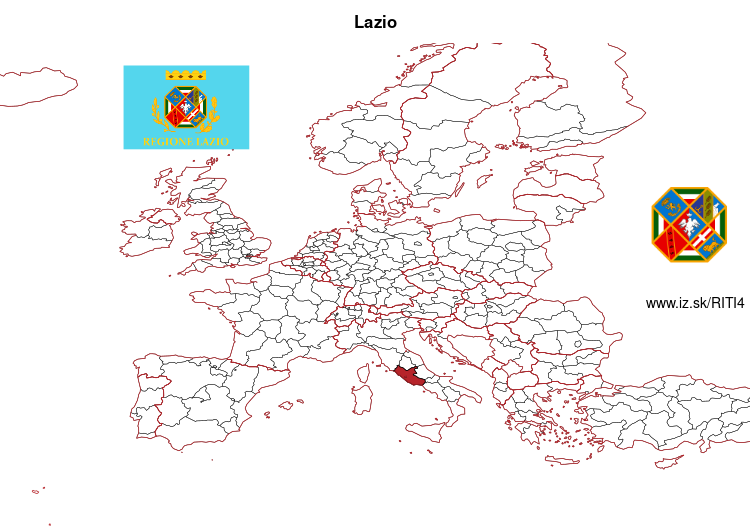
| Indicator | Period | Value |
|---|---|---|
| Life long learning | ||
| life long learning participation | 2024 | 11.3 |
| Part time jobs and flexible employment | ||
| percentage of part time workers | 2024 | 16.39 |
| percentage of part time workers, men | 2024 | 7.49 |
| percentage of part time workers, women | 2024 | 27.8 |
| Gender differences | ||
| gender gap in employment rate | 2024 | 77.18 |
| gender gap in unemployment rate | 2024 | 141.51 |
| Graduates and young people | ||
| unemployment rate of youth with elementary education | 2024 | 30.4 |
| NEET | 2024 | 11 |
| Gross domestic product | ||
| GDP per capita in PPS of EU average | 2023 | 114 |
| Employment | ||
| employment rate | 2024 | 64 |
| Social exclusion | ||
| people at risk of poverty or social exclusion | 2020 | 26.5 |
More on wikipedia wikidata Q1282 on OpenStreetMap Lazio slovensky: ITI4
Subregions: Province of Viterbo, Province of Rieti, Province of Rome, Province of Latina, Province of Frosinone
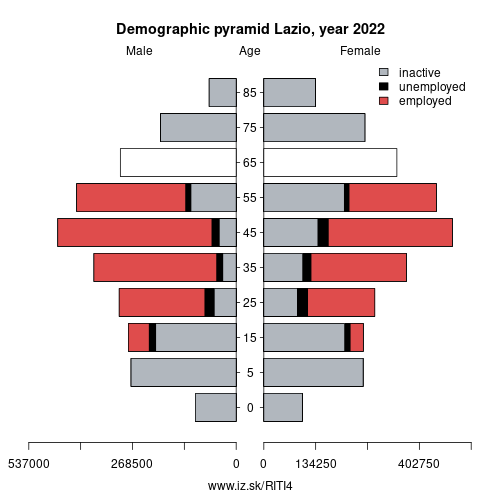
Unemployment
| Indicator | Period | Value |
|---|---|---|
| Unemployment | ||
| unemployment rate | 2024 | 6.4 |
| youth unemployment rate | 2024 | 23 |
| Long term unemployment | ||
| long term unemployment | 2024 | 3.1 |
| share of long term unemployed | 2024 | 49.8 |
Demographics
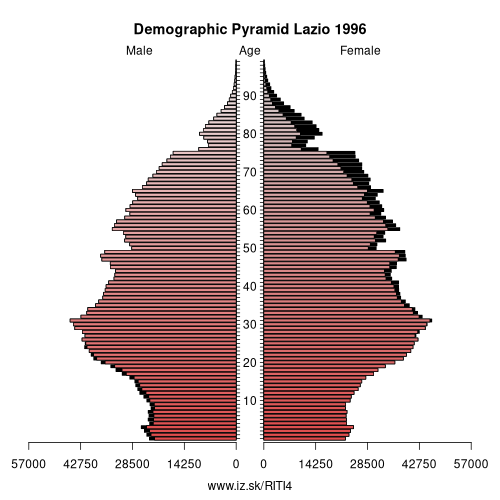
| Indicator | Period | Value |
|---|---|---|
| Demographics | ||
| number of inhabitants | 2024 | 5 714 745 |
| population density | 2023 | 337.2 |
| old-age dependency ratio | 2024 | 36.4 |
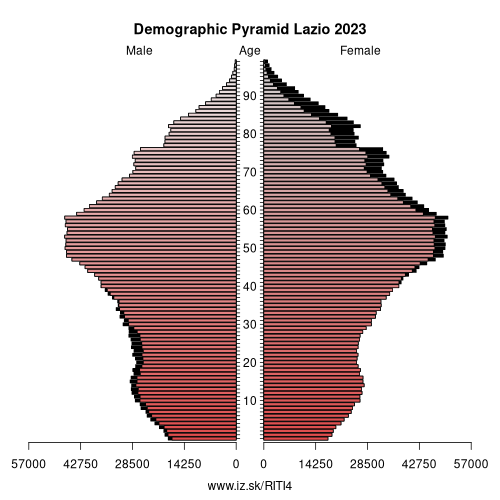
Employment by sectors, Lazio
| NACE r2 | % | NACE r2 | % | ||
|---|---|---|---|---|---|
| A | 54.7 | 2% | B-E | 236.7 | 10% |
| F | 151 | 6% | G-I | 609.8 | 25% |
| J | 162.3 | 7% | K | 79.9 | 3% |
| L | 21.8 | 1% | M_N | 304.5 | 13% |
| O-Q | 561.5 | 23% | R-U | 233 | 10% |
| TOTAL | 2415.1 | 100% |
Data for the period year 2024. Source of the data is Eurostat, table [lfst_r_lfe2en2].
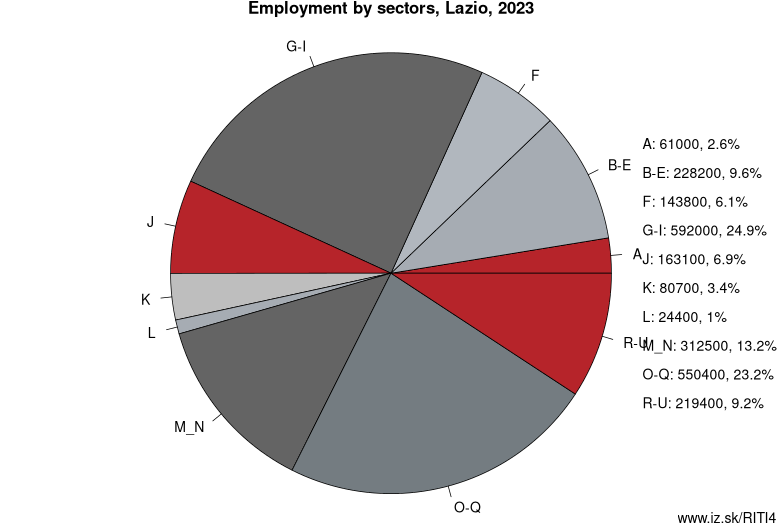
From Wikipedia: Lazio (UK: , US: , Italian: [ˈlattsjo]; Latin: Latium) is one of the 20 administrative regions of Italy. Situated in the central peninsular section of the country, it has almost 5.9 million inhabitants – making it the second most populated region of Italy (after Lombardy and just a little ahead of Campania) – and its GDP of more than 170 billion euros per annum means that it has the nation's second largest regional economy. The capital of Lazio is Rome, which is also Italy's capital and the country's largest city.
Geography
Lazio comprises a land area of 17,242 km2 (6,657 sq mi) and it has borders with Tuscany, Umbria, and Marche to the north, Abruzzo and Molise to the east, Campania to the south, and the Tyrrhenian Sea to the west. The region is mainly flat, with small mountainous areas in the most eastern and southern districts.
The coast of Lazio is mainly composed of sandy beaches, punctuated by the headlands of Circeo (541 m) and Gaeta (171 m). The Pontine Islands, which are part of Lazio, lie opposite the southern coast. Behind the coastal strip, to the north, lies the Maremma Laziale (the continuation of Tuscan Maremma), a coastal plain interrupted at Civitavecchia by the Tolfa Mountains (616 m). The central section of the region is occupied by the Roman Campagna, a vast alluvial plain surrounding the city of Rome, with an area of approximately 2,100 km2 (811 sq mi). The southern districts are characterized by the flatlands of Agro Pontino, a once swampy and malarial area, that was reclaimed over the centuries.
Other: Central Italy, Lazio, Marche, Umbria, Tuscany
Neighbours: Molise, Tuscany, Marche, Umbria, Campania, Abruzzo
Subregions: Province of Viterbo, Province of Rieti, Province of Rome, Province of Latina, Province of Frosinone
Suggested citation: Michal Páleník: Europe and its regions in numbers - Lazio – ITI4, IZ Bratislava, retrieved from: https://www.iz.sk/PITI4, ISBN: 978-80-970204-9-1, DOI:10.5281/zenodo.10200164

 Share
Share Facebook
Facebook Twitter
Twitter News
News